
Real-World Examples And Case Studies

People act like swapping a brand-name part for a knockoff is just “saving money,” but the risks are real and usually show up fast. I’ve seen shops try to shave a few bucks and end up gambling with stuff like airbags or brake pads. Insurers love to call it “practical.” Not sure for who.
Notable Incidents Involving Cheap Parts
I think it was Louisiana where a “repaired” sedan spun out because aftermarket control arms snapped on the highway. No recall, because the VIN said OEM, but the shop swapped in cheap stuff. I keep hearing about brake pads crumbling months after a collision repair, and suddenly a fender-bender turns into a spinout. Receipts always say “equivalent to original.” Sure.
Another mess—airbag modules that never deployed. Mechanics swore up and down the replacements were fine, but they came from discount sites and nobody checked. I read that nearly 80% of independent shops use aftermarket parts over OEM, mostly for “customer demand” or—let’s be honest—shop profits. Here’s some data. Nobody’s really tracking if these swaps actually hurt drivers. It’s like a weird trust fall with no one catching you.
Involvement Of State Farm, Ford, And Others
State Farm—wow, they actually ended up in court for telling shops to use “replacement parts” Ford wouldn’t even warranty. Not some off-brand air freshener, but bumpers, headlamps, structural panels. They called it a “low-cost repair program,” and everyone acted like it was genius. Ford kept warning that these panels might not crumple right in a crash. Did anyone care?
Most people don’t know their insurer quietly pushes for third-party parts. Ford sent bulletins to body shops saying cheap alternatives could wreck crash performance and void all their testing. I’ve seen shops pocket the savings, customers trust that the car’s “fixed,” and nobody finds out until a crash proves otherwise.
This isn’t about brand loyalty—court records show some panels fit about as well as IKEA furniture with mystery hardware. The whole system’s a mess: insurance recommendations, half-truths, frantic shop managers explaining why “good enough” is just “not quite safe.” And somehow, we all keep rolling the dice.
The Impact On Vehicle Resale Value
People love to say they’re cool with non-factory parts—until they want to sell or trade in, and suddenly every little gap or weird panel line becomes a federal case. I mean, sure, a body shop might swear there’s “no difference” between parts, but try telling that to a dealer. Watch them squint at your bumper and start knocking off hundreds.
Diminished Value From Non-OEM Replacements
Honestly, this whole “non-OEM is fine” thing? Maybe for your wallet, but not for resale. Appraisers, I swear, have some sixth sense for sniffing out every aftermarket bit. My cousin’s Accord—looked perfect—dropped nearly 9% in value because the bumper came from some random online site. Not even the right paint code could save it; the pre-sale inspection flagged “aftermarket components” and that was that.
Buyers? They run the other way if they spot mismatched lights or off-brand fenders, especially if it’s a newer car. Dealers don’t care about your “it fits fine” story; they see non-OEM, they start discounting. I talked to this appraisal manager who just automatically knocks off $800 if he sees generic panels. So yeah—cutting corners comes back to bite you.
Appraisals And Disclosure
Trade-in time is just a parade of awkward questions. I’ve seen those appraisal checklists—non-OEM parts get called out right after “accident history.” Sellers try to act like it’s no big deal, but buyers have entire databases of red flags. Missing receipts? Dodgy documentation? Suspicion everywhere. And now, transparency rules force dealers to spill the beans about non-OEM work.
Thinking of hiding it? Good luck. Lenders and buyers use automated systems and people trained to spot this stuff, not to mention VIN tracing and mobile diagnostics. Trade-in offers drop fast if there’s any risk, so that “cheap” strut could cost you $1,500 at appraisal. Paranoid? Maybe, but the math doesn’t lie.
Consumer Protection And Assurance Of Quality
My uncle once bought “OEM-style” brake pads from some sketchy site—mechanic nearly had a meltdown. The problem isn’t just the label; it’s whether the part actually works or if you’re gambling with your safety. “100% OEM style fit,” but the fender’s crooked? Makes you want to scream.
Recognizing Genuine Versus Inferior Parts
Ever stare at a pile of boxes labeled “certified quality” and wonder if any of it means anything? Paint flakes off after one rain, “genuine” airbag sensors fail every test, and those neon warranty stickers? Total joke. Saving £40 isn’t worth wondering if your airbag’s just a dashboard light.
Only real clue is the manufacturer part numbers and batch codes. I always ask to see the packaging before anything gets installed—shops that get offended, I just leave. OEM parts usually have tamper-evident seals, and counterfeiters mess up the font or the logo. I get bored talking about this until someone’s ABS blanks out in a puddle.
Selecting Reputable Repair Shops
Oh man, the shops with 200 “great” reviews and zero actual credentials. Walk in, and it’s just chaos—phones ringing, banners everywhere, nobody knows anything. I asked three places about consumer rights protection, and only one could actually answer.
You can tell a lot: do they list certifications or get weirdly vague about where their parts come from? That’s my cue to bail. “Can I see your brake lathe’s calibration certificate?” If they say “we don’t need one,” I’m gone. The rare shops that send their repairs to independent auditors? That’s who I trust—not the ones pushing “compatible” sensors for half price.
At least the Consumer Rights Act lets me demand a real fix within 30 days if they screw up—assuming I catch it before my next MOT disaster.
